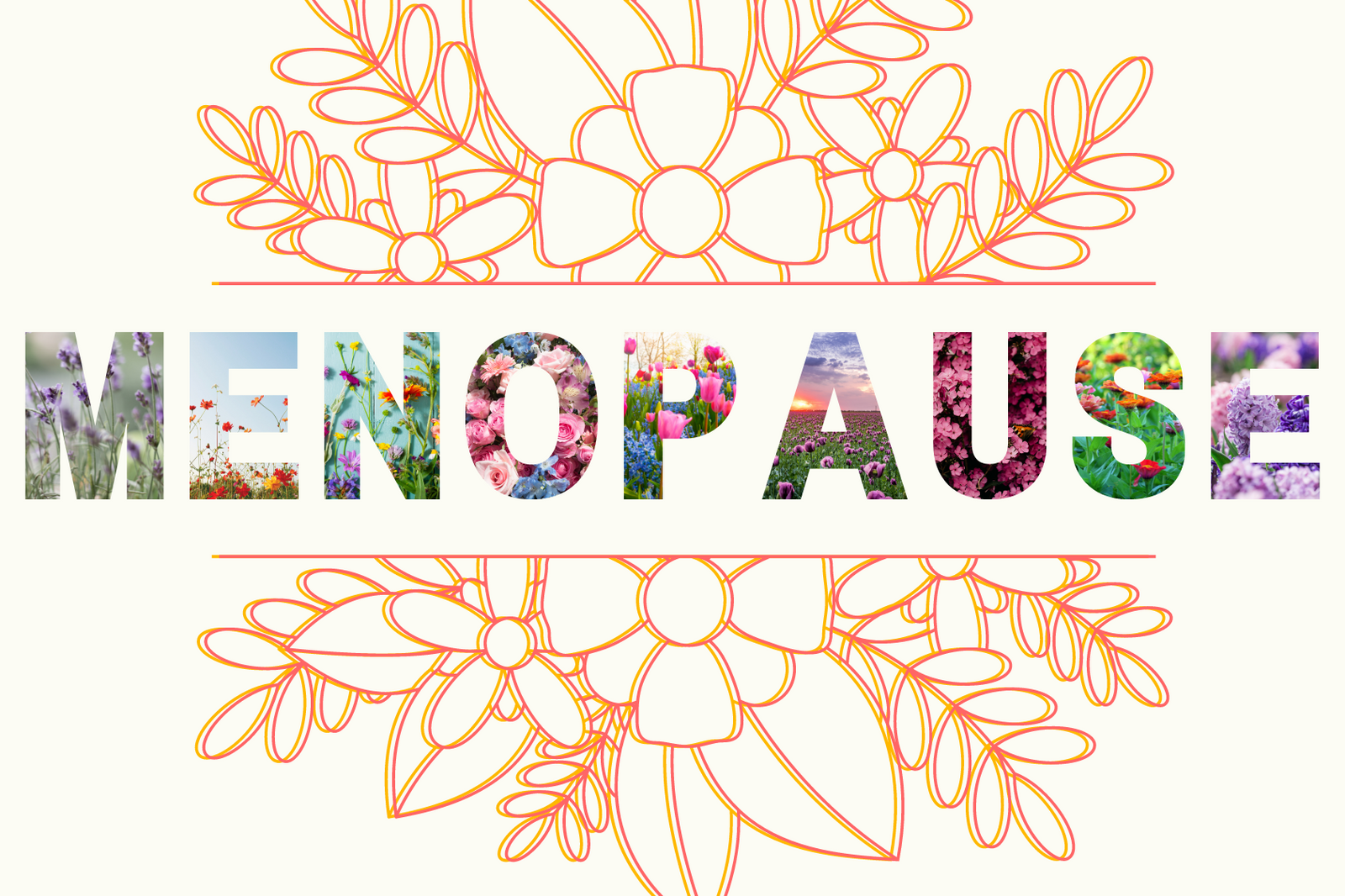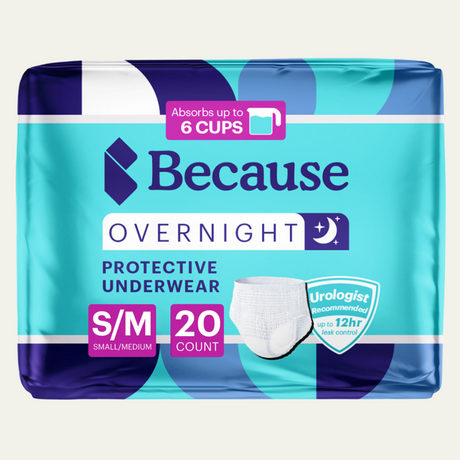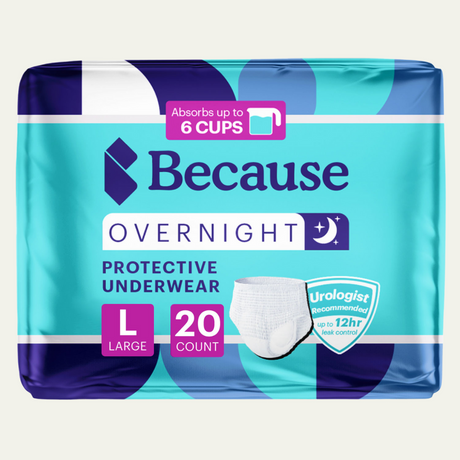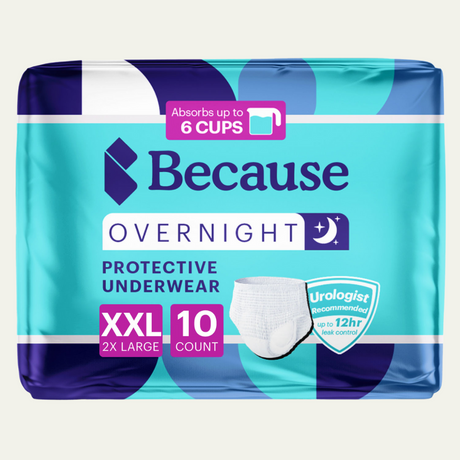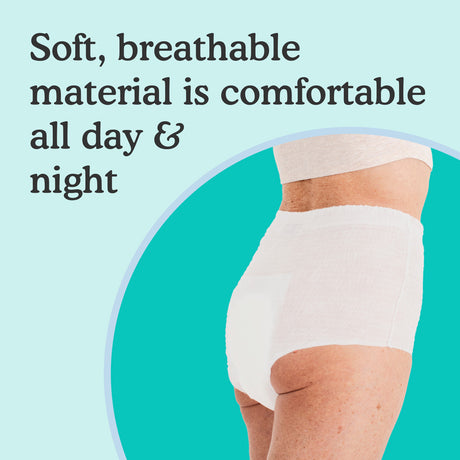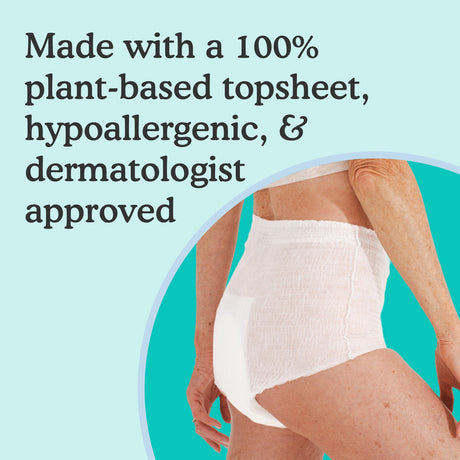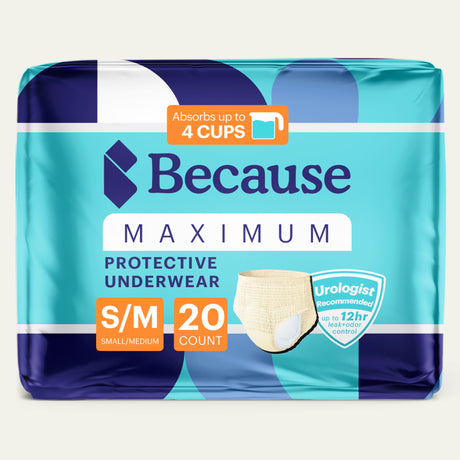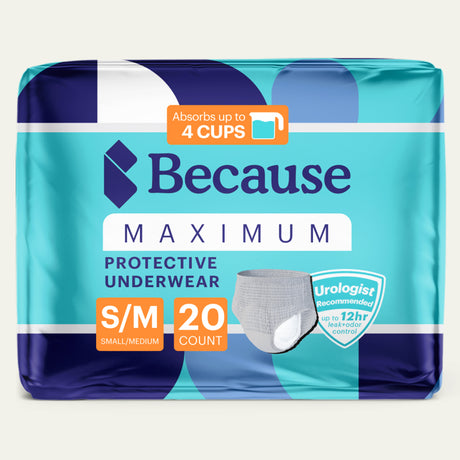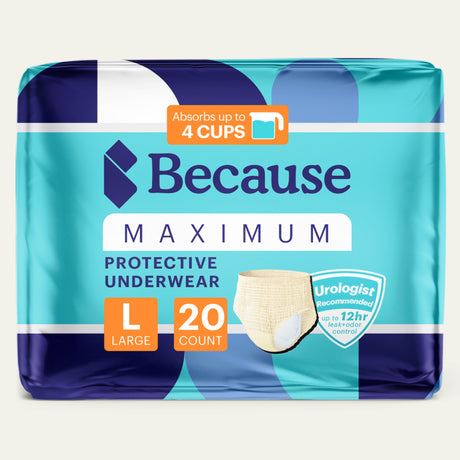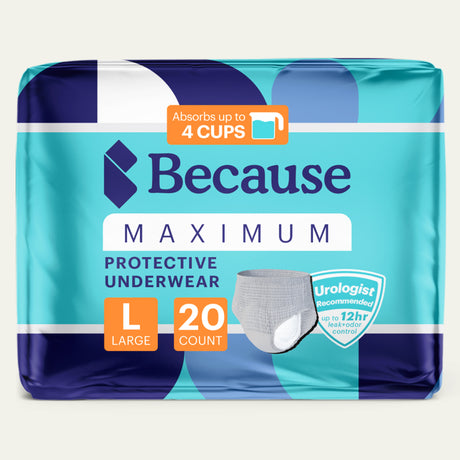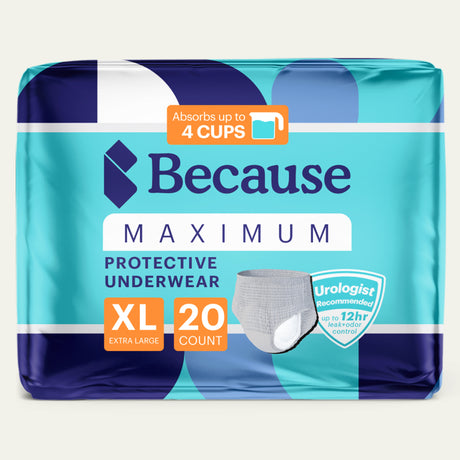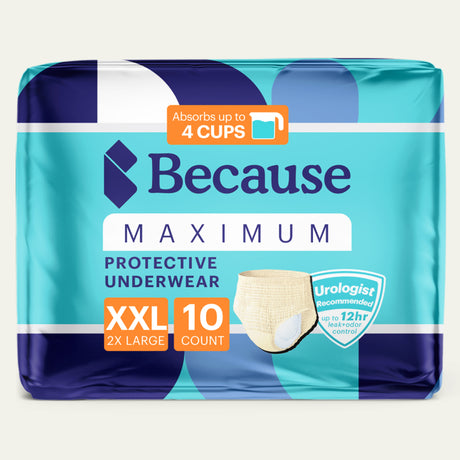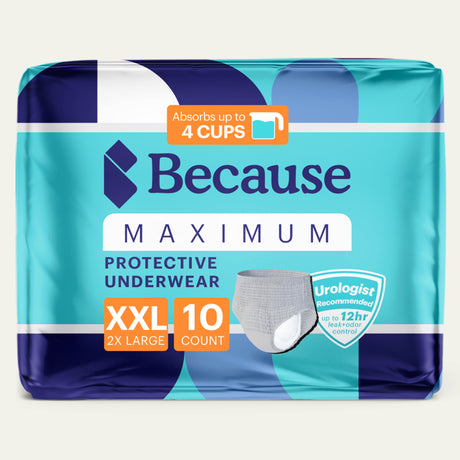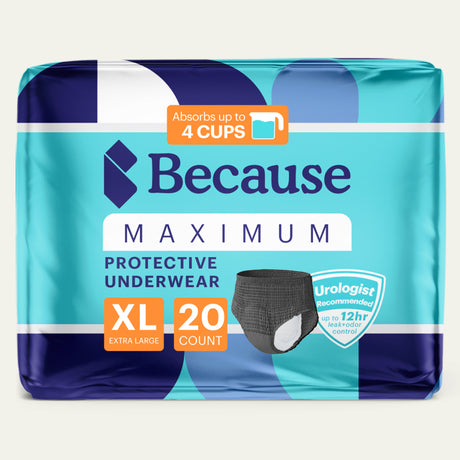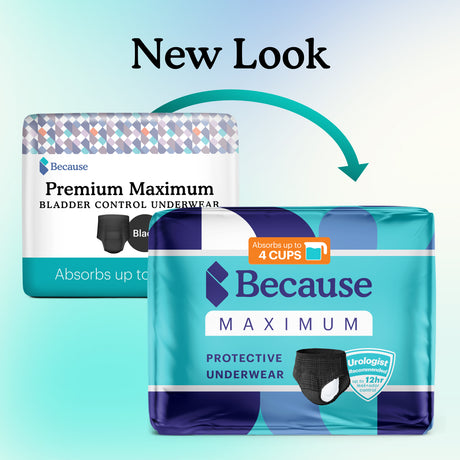During the menopausal transition, women may experience a variety of symptoms, from hot flushes to vaginal dryness to mood swings. Many menopausal symptoms resolve within a few years after postmenopausal women stop having menstrual periods, but some, like urinary incontinence (UI), remain ongoing issues. The good news is that there are things that you can do to address bladder control issues related to menopause. Read on to learn about the connection between menopause and incontinence and how you can manage bladder problems.
What is Menopause and Menopause-Related Incontinence?
Menopause-related incontinence refers to a lack of bladder control related to menopause, which is when women’s menstrual cycles end. Healthcare professionals will diagnose patients with menopause when they have gone for 12 consecutive months without a menstrual period. In the U.S., the average age for menopause is 51 years, and most women experience it between the ages of 45 and 58.
The period that leads up to menopause is known as perimenopause. It lasts an average of four years but can be as short as a few months or as long as several years. Menopause incontinence may begin during perimenopause or after menopause occurs.

Why Does Menopause Cause Incontinence?
Urinary incontinence is a common problem in perimenopausal and postmenopausal women. Hormone changes are the underlying reason that menopause contributes to symptoms of urinary incontinence. Let’s explore how and why hormone changes occur and what effects these changes have.
What Happens to Estrogen Levels During Menopause?
During perimenopause, the ovaries decrease their production of estrogen and progesterone, the female sex hormones that regulate the menstrual cycle and perform other functions in the body. After menopause occurs, levels of these hormones are much lower.
Physical Changes That Contribute to UTI Symptoms
Hormonal changes that occur during menopause lead to physical changes. Genitourinary syndrome of menopause, a condition previously known as vulvovaginal atrophy, atrophic vaginitis, or urogenital atrophy, describes the spectrum of changes caused by the lack of estrogen during menopause. With lower estrogen levels, the lining of the vaginal walls becomes drier and thinner. Women with vaginal atrophy may experience a variety of symptoms, including urinary incontinence, frequent urinary tract infections (UTIs), burning and itching in the vagina, and pain during sexual intercourse due to changes in vaginal tissue.
Menopause can also affect the urethra, the tube that carries urine from the bladder out of your body. Reduced estrogen levels can cause the urethra to shorten and lead to weakness in the urethral sphincter and support structures that control urine flow.
Finally, when estrogen levels fall, the pelvic floor muscles that support the bladder may grow weak, and this reduced muscle tone can lead to the involuntary leakage of urine.

Types of Urinary Incontinence That Are Influenced By Menopause
There are three main types of urinary incontinence, and menopausal changes can contribute to each. They include all of the following.
Stress Incontinence
One of the most common types of urinary incontinence among all women, stress incontinence is the leaking of urine that occurs when pressure is applied to the bladder. If you have urinary stress incontinence, you may experience bladder leaks when you cough, sneeze, laugh, exercise, or perform heavy lifting.
Stress incontinence arises from dysfunctional pelvic floor function. This includes weakness, excess muscle tone, and prior injuries. When the pelvic floor is weaker than it should be, urine can leak more easily.
Overactive Bladder (OAB) & Urge Incontinence
Overactive Bladder is a condition that causes bothersome urinary frequency and urgency. When the sudden urge to urinate leads to leaks, this is called urge incontinence.
A common reason for overactive bladder is when the bladder muscles spasm irregularly. Changes in hormone levels that happen with the onset of menopause can contribute to these spasms. A variety of medical conditions, like diabetes, stroke, and multiple sclerosis, can also contribute to poor bladder control. When a neurologic condition contributes to poor bladder function this is called neurogenic bladder.
Stress incontinence and urge incontinence can co-exist in many women. This is known as mixed urinary incontinence.
Overflow Incontinence
Overflow incontinence is a type of incontinence that occurs when a person is unable to empty their bladder completely. The bladder becomes too full, resulting in urine leakage.
The reasons why the bladder does not empty can include bladder muscle weakness (age-related or due to medications or other medical treatments) or an obstructed or “blocked” urethra.
Recognizing the Symptoms Associated With Menopause
If you are bothered by any of the symptoms below, they may warrant further evaluation by a doctor. Some conditions can be discussed with your primary care provider, and others warrant specialist care provided by gynecologists, urogynecologists, and urologists.
- Leaks, which could be as little as a few drops of urine or a complete loss of bladder control
- Urine leakage that occurs during certain physical activities like exercising or laughing
- Frequent urination
- Sudden intense urge to urinate
- Waking up more than twice per night to urinate
- Bedwetting
- Leakage of urine during sexual intercourse

Diagnosis and Treatment Options
To diagnose incontinence related to menopause, doctors typically begin with a detailed history and possibly a physical examination. Based on their findings, they may order:
- Urinalysis and urine cultures to rule out infections and other conditions
- Bladder stress test, where pressure is applied to the bladder to check for leaks
- Imaging tests, like X-rays and ultrasounds
- Urodynamic tests of bladder function, in order to measure urine flow, pressure, and volume
- Cystoscopy, where a doctor inserts a thin lighted tube with a camera into the urinary tract
Your healthcare provider may also ask you to keep a diary to track how frequently you urinate and experience leaks. Once your doctor has determined the cause of your incontinence, they may recommend treatments, such as:
- Avoidance of bladder irritants
- Vaginal estrogen cream or tablets: This is a safe and effective treatment that reverses changes seen in postmenopausal women. Estrogen is negligibly absorbed, and thus not linked to any significant risk of cancer or blood clots.
- Pelvic floor physical therapy
-
Treatments for overactive bladder and urge incontinence:
- Medications: Anticholinergics (including oxybutynin, solifenacin, trospium) and beta-3 agonists (Mirabegron, Vibegron) can help reduce bladder spasms and may be prescribed for women with OAB or urge incontinence. Caution should be taken with anticholinergic medications in older patients over 65.
-
- Sacral nerve stimulation: Sacral nerve stimulation is a minimally invasive procedure in which a device that delivers mild electrical current is implanted at the base of the spine to control bladder spasms related to urge incontinence. This can control more severe symptoms long-term.
- Botox: Injections of botulinum toxin into the bladder may significantly reduce symptoms of overactive bladder.
-
Treatments for stress incontinence:
- Vaginal pessary: This flexible silicone ring is worn all day in the vagina to support the urethra and reduce leaks.
- Urethral inserts: These small tampon-like devices may be inserted prior to certain daily activities like exercise to stop bladder leaks.
- Bulking material injections: Bulkamid and similar injections administered to the urethra may help to keep the urethra closed to prevent leaks.
- Sling procedures: With this type of surgery, mesh or natural body tissue is used to create a sling that supports the bladder to reduce stress incontinence symptoms.
- Burch urethropexy procedure: this is a mesh-free option for some patients that supports the urethra.
Typically, doctors initially recommend conservative treatments like vaginal estrogen, medications, and injections, turning to surgical procedures only when less invasive interventions do not lead to adequate symptom improvement.

Prevention Strategies for Incontinence After Menopause
Making lifestyle changes and adding activities to your daily life may help reduce your risk of developing urinary incontinence or improve your symptoms if you already have bladder symptoms. The following are some things that may help.
Pelvic Floor Exercises
Weak pelvic floor muscles are one of the biggest risk factors for menopause stress incontinence, so supporting muscle strength during menopause is a great first step toward lowering the likelihood of bladder control problems. You can do so by performing pelvic floor exercises at home.
Kegel exercises are often the best way to promote stronger pelvic muscles. To do them, you tighten the muscles of your pelvic floor the same way you would if you were trying to stop the flow of urine. Hold for three to five seconds and then relax for three to five seconds. Typically, healthcare providers recommend repeating Kegel exercises 10 times in a row, three times per day. Sometimes pelvic relaxation is more important than strengthening. Physical therapists can help improve the function of your pelvic floor and tailor a treatment plan for you.
Bladder Training
Bladder training is when you follow a urination schedule that your doctor helps you establish. Even if you don’t feel the urge to urinate, you still make regular trips to the bathroom, and when you get the urge to urinate, you try to wait until your next scheduled bathroom break. Over time, bladder training may allow you to go for longer without urinating and provide relief from urinary urgency.
Healthy Diet and Lifestyle
Menopause is a great time to rethink your diet and lifestyle. Weight gain is common after menopause and can worsen incontinence, as excess body weight increases pressure on the bladder. Following a healthy diet and exercising regularly can support weight loss or help you maintain a healthy weight after menopause. Even moderate weight loss can lead to improvement in urinary leakage.
Reducing your intake of foods and drinks that can irritate the bladder may also improve incontinence symptoms. Some foods and beverages that may be a good idea to avoid include:
- Foods and drinks that contain caffeine, like coffee, tea, energy drinks, and chocolate
- Alcohol
- Acidic foods, like citrus fruits, vinegar, and tomato-based products
- Spicy foods, like curries and chilies
- Fatty and fried foods, like fast food, potato chips, and lunch meats
In addition to limiting your alcohol and caffeine intake and cutting back on bladder-irritant foods, be sure to drink enough fluids on a daily basis to prevent dehydration. Your healthcare provider can give you specific information on how much you should drink each day.

Living With Menopause and Incontinence
Treatments and lifestyle changes can help to reduce incontinence symptoms, but it can take time to see results. Fortunately, there are things you can do to manage incontinence in the meantime. Follow these tips:
Seek Mental Health and Emotional Support
Incontinence can have a negative impact on your self-esteem and self-confidence. Talking to others about your symptoms can help you work through your feelings. You can turn to trusted friends and family members and/or seek out a mental health professional.
If you're struggling with incontinence, join one of our private support groups today!
Women's Incontinence Support Group
Men's Incontinence Support Group
Dealing With Incontinence Outside the Home
Urinary incontinence doesn’t have to interrupt your social life or get in the way of your daily activities. Bladder protection products like incontinence pads and underwear can help you keep dry when you’re on the go.
When choosing bladder protection, look for products for women that are the right absorbency for your needs. For little bladder leaks, moderate absorbency may be adequate, and maximum or overnight protection is available for more severe leakage.
To simplify incontinence protection changes when you’re away from home, bring along disposable incontinence wipes, which can quickly cleanse your skin and help control odors. Carrying disposable incontinence supply bags with you will allow you to throw away used incontinence products discreetly.
Coping With Night-Time Incontinence
If you experience incontinence at night, the right incontinence products can help you deal with accidents more easily. Comfortable overnight incontinence underwear can be worn alone or with booster pads to capture leaks. You may also want to consider using disposable bed protectors to keep your mattress clean.
When to See Your Doctor
The information provided in this piece isn’t a substitute for medical advice. Talk to your healthcare provider whenever you experience symptoms of menopause incontinence. They can recommend the best treatments for your needs and small changes that you can make to your diet, lifestyle, and daily routine that can help you manage incontinence over the long term.
Are you struggling with menopause incontinence? Take our bladder protection quiz and get a sample pack to try.
Sources:
Office on Women's Health. (2023). Menopause Basics. Women's Health. https://www.womenshealth.gov/menopause/menopause-basics
MedlinePlus. (n.d.). Menopause. Patient Education. https://medlineplus.gov/ency/patientinstructions/000141.htm
